Introduction
In November 2005 a Photo-Voltaic array was installed on the roof of St James's Church, Piccadilly, London.
The PV system generates non-polluting electricity and feeds it into the church where we can use it for lighting and other electrical equipment.
There has been a lot of interest in the installation so we have put these web-pages together to provide some information. This page shows a set of photographs of the various components of the PV system. The other page ( Photovoltaic Questions and Answers) will list some answers to the common questions we are getting (through this website) from people who want to install PVs on their own buildings.
This web site is still under construction, and we will be adding new bits over the next few weeks. If you have any questions in the meantime please feel free to contact me.
Simon Dawson

|
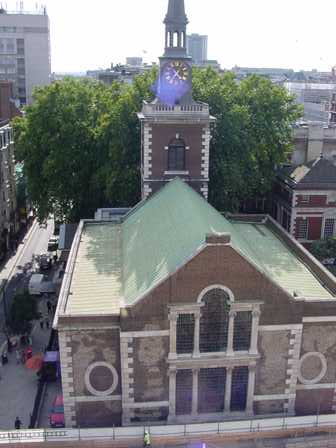 |
Frame 1. The Church Roof
This shot shows the layout of church roof before system installation. Most of the PV panels were mounted on the long flat roof over the south aisle to the left of the picture. Six more panels, and the inverters, were placed on the small area of flat roof you can just see alongside the tower.
Nearly all churches are aligned East/West, and so they often have south facing roofs which are ideal for solar power generation.
|
|
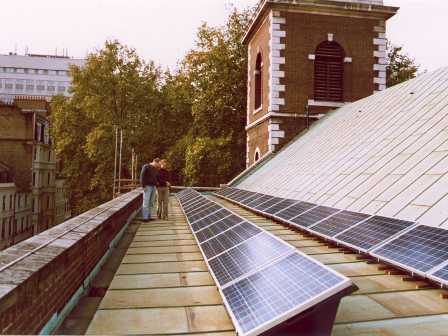 |
Frame 2. The Photo Voltaic Panels
We have 34 panels mounted on the church roof over the south aisle. (Six additional panels are on a smaller bit of roof over the south lobby).
The panels are angled to face the sun.
This size of array is rated at 5KW (peak). It is estimated that it will generate 4,100 KW hours per year, and save about 1.8 tons of carbon dioxide per year.
|
|
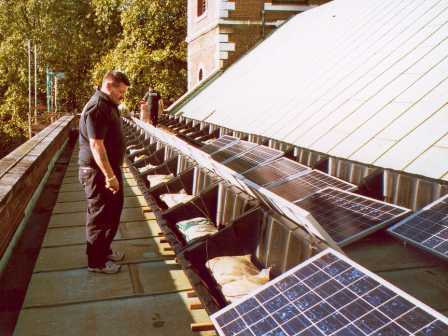 |
Frame 3. Installing the System
This shot shows the PV panels during installation. You can see that each panel is supported by a moulded plastic box, specially shaped to hold the panel at the correct angle to the sun. Each box is weighted down with two bags of gravel.
We chose this system for two reasons.
1. It means that there are no securing bolts or fixings holding the panels to the roof - and thus less impact on the historic structure of the Christopher Wren designed church.
2. It will be easy to move the panels aside when we want to renovate the church roof in a few years time.
|
|
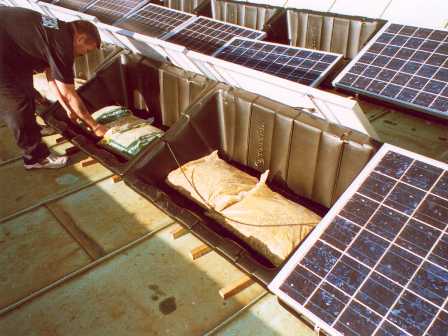 |
Frame 4. Installing the System
Another shot of the inner working of the frame, showing the gravel weights. The designers (PV Systems Ltd) call this the "Console System".
You can also see some simple hardwood battens, which are placed beneath the units to protect the copper roof.
|
|
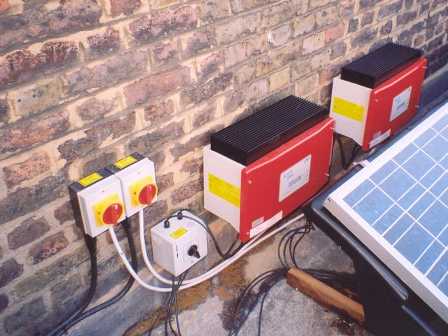 |
Frame 5. The Electronics
There is a corner of a PV panel in the bottom right of the picture.
The large red boxes are inverters which take the electrical current from the panels, and convert it to mains voltage, so it can be fed into the churches electrical system.
The smaller boxes are isolating switches, so we can cut off the power for safety if an electrician wants to do maintenance on the system.
|
|
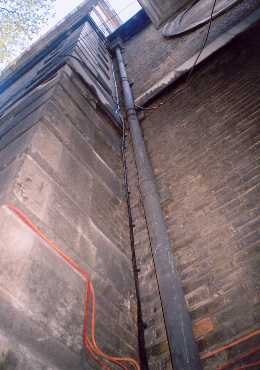 |
Frame 6. Cabling
This shows the cable which brings the power from the roof, down the side of the tower, and into the church. It is the black cable secured right into the corner.
Although this is a small part of the system it was actually quite an expensive part. The cable is armoured for protection, and we had to employ specialist abseilers to fix it in place, as we could not get scaffolding into such a constricted area.
|
|
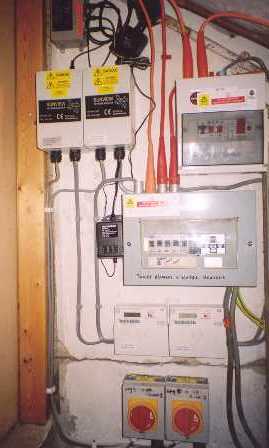 |
Frame 7. Connecting into the Church Electrics
The power is brought down off the roof into this small switch-room in the church through the two isolators in the bottom of the picture. From there the cable runs through some kilowatt-hour sensors which provide data to the display board (see below), and then into two of our consumer units.
We calculated that the church will always be using more electricity than the PV system can generate, and this means that the connection and metering can be quite simple.
We draw down power for use in the church from these consumer units. For every unit of electricity fed into the consumer units from the PV, we need to import one less unit from the National Grid through our normal electricity meters. These meters will therefore register less consumption, and the saving to the church comes through lower electricity bills.
If we had a larger system which exported and sold a significant amount of electricity back into the grid then we would have needed a more complex metering system to accurately measure the exported power.
|
|
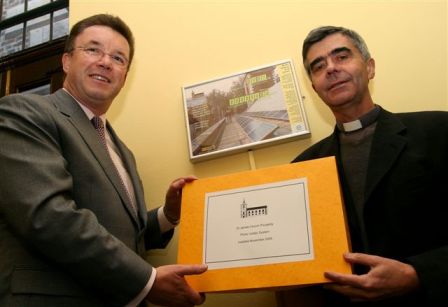 |
Frame 8. Display Panel
This final bit of equipment is a display panel in the church lobby - telling our many visitors about the PV system.
It is shown here on the day of the launch ceremony being uncovered by Derek Lickorish (EDF Energy’s Chief Operating Officer, Customers Branch) and our rector, Charles Hedley. Mr Lickorish represented our main sponsor, the EDF Energy Green Energy Fund.
The LCD displays on the panel indicate the power being generated currently, and the total power generated since system installation.
The actual Artwork for the Display Panel also downloadable (be warned - it is a 3 Megabyte file)
|
|
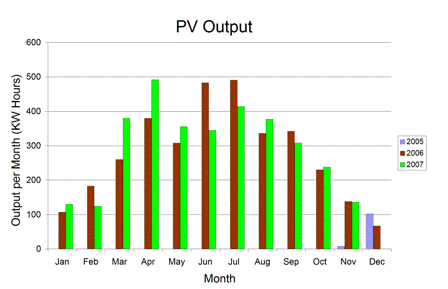 |
Frame 9. System Output
(Click on the graph for a bigger version - which is updated monthly.)
Finally, this is a graph of the system output measured monthly since installation in late November 2005. The graph clearly shows the seasonal variation in output, and the dip in output during the very rainy weather of May 2006 and summer 2007.
We saw the project as test-bed, as described in our grant application:
- To demonstrate to various professional communities that forward-looking sustainable technologies can co-exist with a Grade 1 listed historic building.
- To demonstrate the benefits of solar power to our own community and to the 5,000 visitors to our site each week.
- To help meet the electrical needs of our church building in as green a way as possible, using the renewable resource of the sun, reducing associated CO2 emissions.
We wanted to show that it actually was possible to install green technology within a historic church, and overcome all the technical, aesthetic, conservation and planning problems which that would create. We feel this has been very successful, and we have been really pleased with the interest shown by other churches who are inspired to go on and build even bigger and more powerful green energy systems. So our first two aims have been successful.
As for the third reason - generating power - we admit that when compared to the total power needs of our church buildings, this system gives us quite a small proportion of it, but it is a start. Every little helps.
|
|
|
|